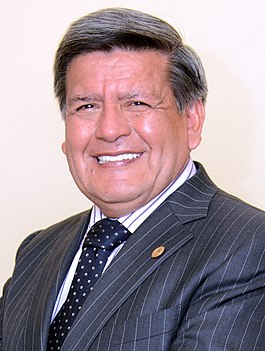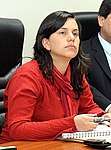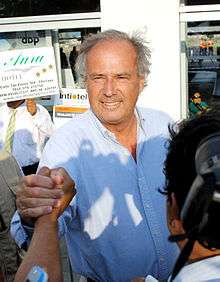2021 Peruvian general election
The next Peruvian general election is scheduled to be held on 11 April 2021, to determine the President, Vice Presidents and the composition of the Congress of the Republic of Peru. However, President Martín Vizcarra announced that he would present a constitutional reform to call a snap election by April 2020. Opposition lawmakers condemned Vizcarra's proposal, defending the practice of five year terms.[1] This constitutional reform was rejected.[2]
| |||
|
| |||
| |||
 |
|---|
| This article is part of a series on the politics and government of Peru |
| Constitution |
|
|
|
|
Autonomies
|
|
|
|
|
|
|
Electoral system
The President is elected using the two-round system. The 130 members of Congress are elected in 26 multi-member constituencies using open list proportional representation. To enter Congress, parties must either cross the 5% electoral threshold at the national level, or win at least seven seats in one constituency. Seats are allocated using the D'Hondt method.[3][4]
Date
The 2021 Peruvian general election will be held on April 11, 2021, to elect the president of the Republic of Peru, two vice presidents of the same party, 130 congressmen of the Congress of Peru and 5 Andean parliamentarians for a five-year term from 2021 to 2026.
The President and Vice Presidents of the Republic are elected by direct suffrage and in a single electoral district. In the event that no presidential candidate reaches more than 50% of validly cast votes, a second electoral round will be held.
On April 11, 130 congressmen will be elected in 26 electoral districts, corresponding to the 24 departments, the Province of Lima and the Constitutional Province of Callao. The procedure of the distribution figure with optional double preferential vote will be used.
The elected congressmen will be sworn in and assume office no later than 27 July 2021; the constitutional president of the Republic and his elected vice presidents will do so on 28 July 2021.
Early election proposal
President Martin Vizcarra presented legislation that would set the conditions for a snap election in 2020. If successful, Vizcarra would not be eligible for re-election. The 2020 proposed Peruvian general election would be held on April 11, 2020, to elect a new President of the Republic of Peru, along with 130 congressmen of the Congress of Peru. It was eventually decided to be held on 26 January 2020.
Potential candidates
| Major Candidates | |||||||||||||||||||||||||||
| George Forsyth | César Acuña | Keiko Fujimori | Julio Guzmán | Verónika Mendoza | Daniel Urresti | Alfredo Barnechea | |||||||||||||||||||||
|---|---|---|---|---|---|---|---|---|---|---|---|---|---|---|---|---|---|---|---|---|---|---|---|---|---|---|---|
 |
 |
 |
 |
 |
 |
 | |||||||||||||||||||||
| Mayor of La Victoria (since 2018) |
Governor of La Libertad (2015) |
Member of Congress (2006–2011) |
Secretary General of the Office of the Prime Minister (2012–2013) |
Member of Congress (2011–2016) |
Minister of the Interior (2014–2015) |
Member of the Chamber of Deputies (1985-1990) | |||||||||||||||||||||
| Independent | Alliance for Progress | Popular Force | Purple Party | New Peru | Podemos Perú | Popular Action | |||||||||||||||||||||
| Expressed Interest | Expressed Interest | Announced | Announced | Expressed Interest | Expressed Interest | Expressed Interest | |||||||||||||||||||||
Notes
References
- "Peru's Vizcarra proposes early elections, opposition cries foul". Reuters. 28 July 2019. Retrieved 28 July 2019.
- "Perú.- El Congreso rechaza la reforma constitucional y el adelanto electoral propuestos por Vizcarra". notimérica (in Spanish). 29 September 2019. Retrieved 26 September 2019.
- Peru IFES
- Resultados Congresales ONPE